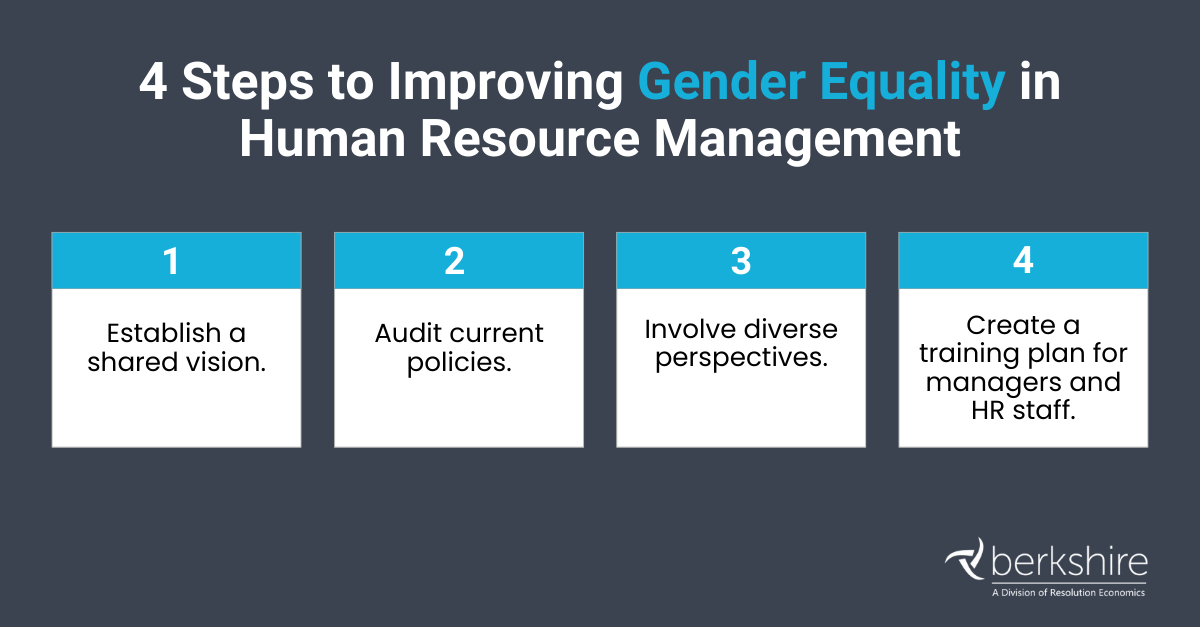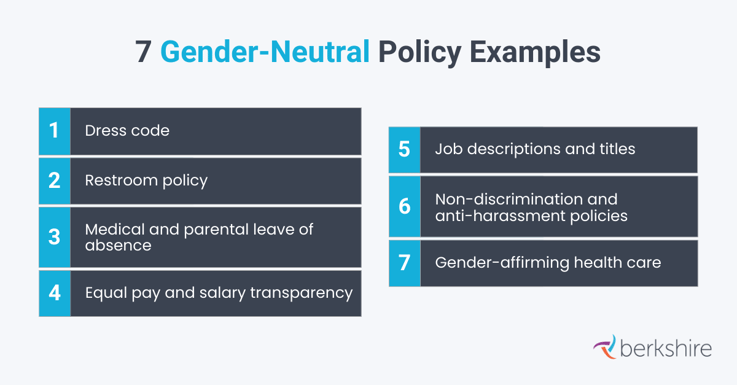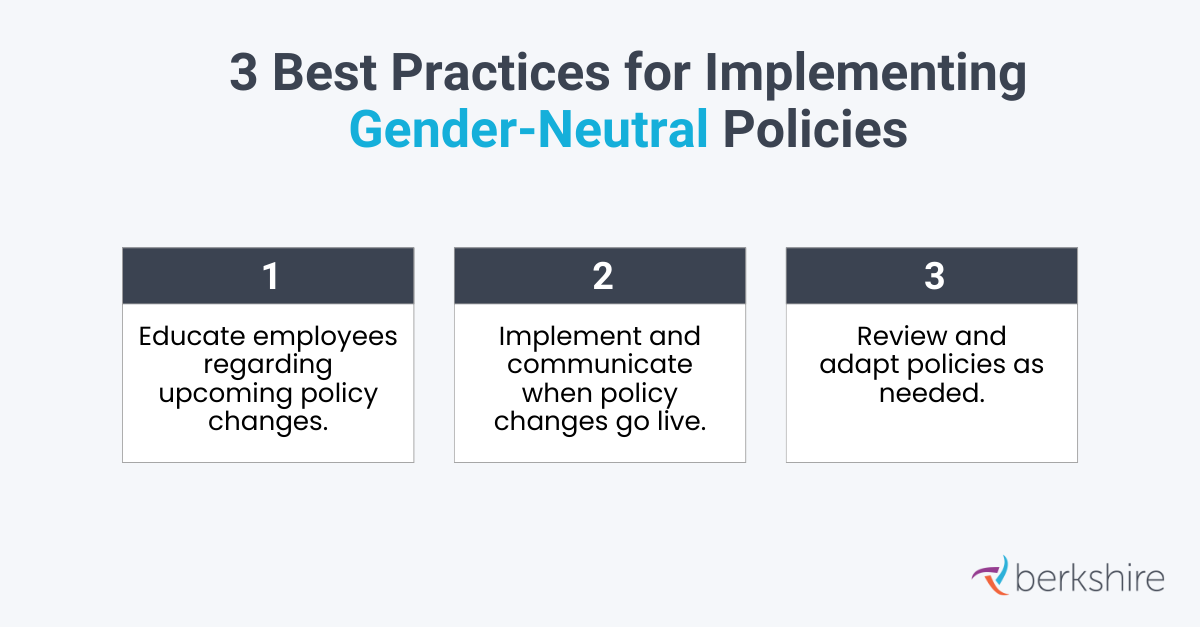Creating gender-neutral employment policies represents a powerful illustration of how business leaders can build fair work environments for all employees. This approach isn't just about words; it's a fundamental way in how organizations function, making sure that every employee — regardless of gender or gender identity — feels respected, valued and empowered to do their best work.
Transgender and gender non-conforming employees don’t always feel welcome at work. Three-quarters of employees responding to Deloitte’s Global 2023 LGBT+ Inclusion @ Work Survey believe it’s important to be able to freely express their gender identity at work. But less than half feel comfortable being out around their colleagues.
Although gender-neutral policies might appear straightforward, their implementation is a path filled with both challenges and opportunities. If we're going to make progress on gender equality, we need to understand why gender-neutral workplace policies matter and how to create them.
Learn how to take steps toward creating gender-neutral policies in your organization and check out some gender-neutral policy examples to inspire change.
What Is Gender-Neutral Policy, and Why Does It Matter?
Gender-neutral policies in the workplace encompass rules, guidelines, and practices designed to be inclusive and unbiased regarding gender. They are formulated to ensure that all employees are treated fairly and respectfully, regardless of their gender, gender identity or expression. These policies are a response to the recognition that traditional gender-specific policies can lead to discrimination, unequal opportunities and a lack of inclusivity in the workplace. A policy that specifies different grooming standards and clothing expectations based on gender, for instance, ignores the existence and needs of individuals who may not identify within the binary definitions of male or female. It can lead to exclusion and discomfort for these employees who don't fit into the prescribed dress code categories, and potential discrimination against those who don’t adhere to the standard.
Gender-neutral policies create a more inclusive work environment where all employees, regardless of their gender or gender identity, feel valued, respected, and accepted.This inclusivity contributes to a sense of belonging and can enhance employee morale and well-being. Although gender identity is only one aspect of diversity, achieving a welcoming and inclusive environment for all employees, including transgender and non-binary employees, contributes to a comprehensive culture of belonging.
By removing gender-based barriers, organizations can tap into the full potential of their workforce. When employees are free to be themselves and are not held back by gender-related biases, they can contribute more creatively and effectively to the organization's success.
Beyond being the right thing to do to help your people work at their best, there are laws to protect employees from discrimination based on gender expression. In the Bostock case of 2020, for instance, the Supreme Court ruled that discrimination against someone based on their sexual orientation or gender expression is prohibited under Title VII. This and other legal requirements are imposed by the EEOC and OFCCP (for applicable contractors).
4 Steps to Improving Gender Equality Through HR Policies and Procedures
Here are some ways the DEI and HR leaders can write and implement gender-neutral HR policies and procedures.
Establish a Shared Vision
Align on the shared goal of creating gender-inclusive policies that promote fairness and equal opportunities for all employees. This shared vision will guide the development and implementation of inclusive HR policies.
Audit Current Policies
Review existing HR policies to identify any gender biases or gaps. This audit will help identify areas where gender-inclusive policies need to be developed or existing policies need to be revised.
Involve Diverse Perspectives
Consider gathering feedback from employees. By involving diverse perspectives, HR leaders can make sure that gender-inclusive policies are comprehensive and address the specific challenges faced by different gender identities.
Create a Training Plan for Managers and HR Staff
Anti-bias training is especially important for people whose decisions can impact inclusion at work. Recruiters and hiring managers, for instance, heavily influence who comes into the organization — and research from Business.com found that managers were less likely to want to contact an applicant whose resume included “they/them” pronouns.
To effectively conduct comprehensive training sessions for recruiters and HR staff, highlight the importance of diversity, equity and inclusivity in driving organizational success and creating a welcoming atmosphere for all employees. Introduce practical strategies for recognizing and addressing unconscious biases in recruitment, promotion and workplace practices.

7 Gender-Neutral Policy Examples
Many of our policies and protocols are so ingrained in workplace culture that it can be challenging to step back to see how they might affect transgender and gender-non-conforming workers. Check out these gender-neutral HR policy examples to inspire change in your organization.
Dress Code
A gender-neutral dress code policy allows employees to dress in a manner that aligns with their gender identity and personal preferences. It refrains from specifying clothing options based on traditional gender stereotypes and ensures that all employees can choose their attire comfortably and professionally.
An example of a gender-neutral dress code policy might be one that has a blanket dress code across the workforce, without any stipulations for how a person with a specific gender identity might dress. Key words to avoid would be “women”, “men”, “he/his”, or “she/her”.
Restrooms and Changing Facilities
A gender-neutral bathroom policy ensures that all employees have access to restrooms and changing facilities that correspond to their gender identity, rather than their assigned or perceived gender. It promotes inclusivity and prevents discrimination against transgender and non-binary employees.
Medical and Parental Leave of Absence
Gender-inclusive medical and sick leave policies ensure that all employees have access to necessary medical care, regardless of their gender or gender identity. These policies may go beyond what’s traditionally covered by the Family and Medical Leave Act (FMLA) to encompass a range of medical conditions and procedures, including gender-affirming surgeries, fertility treatments, and mental health support. By providing equal access to medical leave, businesses promote inclusivity and support the physical and mental health needs of all employees.
Similarly, gender-neutral parental leave policies recognize that caregiving responsibilities are not limited to one gender. These policies provide equal opportunities for all employees to bond with and care for their newborn or adopted child, regardless of their gender, gender identity or biological relationship to the child. By offering gender-inclusive parental leave, businesses promote gender equality, reduce gender stereotypes, and support employees in their personal and family lives, ultimately contributing to higher employee satisfaction and retention.
Equal Pay and Salary Transparency
A gender-inclusive equal pay policy helps ensure that compensation is based on job responsibilities, skills, and qualifications rather than gender. It promotes transparency in salary structures, making it easier to identify and address any disparities that may exist.
This policy emphasizes pay equity, making sure that employees receive fair compensation for equivalent work, regardless of gender. It also promotes salary transparency, allowing employees to be aware of pay scales and take the necessary actions to address disparities.
Job Descriptions and Job Titles
By adopting inclusive language in job descriptions and titles, your business can attract a wider pool of talent, create a more inclusive work environment, and challenge traditional gender norms.
Gender-neutral job descriptions ensure that the language you use to outline roles doesn’t reinforce gender biases or stereotypes. By using neutral and inclusive language, you can attract a diverse range of candidates and create a level playing field for all applicants. This approach helps to break down barriers and increase opportunities for individuals who may not conform to traditional gender expectations.
Similarly, gender-neutral job titles recognize and respect the diverse identities and experiences of employees. It’s important not to use gender-specific job titles — such as salesman, fireman, waitress, or stewardess, for instance — to prevent coding certain roles as masculine or feminine.
Updating external, candidate-facing content (like job postings) helps you create an attractive and inclusive employer brand.
Non-Discrimination and Anti-Harassment Policies
Many transgender and gender non-conforming employees are at higher risk of negative experiences, ranging from misgendering and deadnaming (referring to a transgender or non-binary person by a name they used prior to transitioning) to, in some cases, workplace violence. Nearly half (44%) of transgender or gender non-conforming U.S. employees surveyed by Boston Consulting Group reported experiencing sexual harassment or misconduct at work.
A comprehensive non-discrimination and anti-harassment policy explicitly prohibits discrimination and harassment based on gender identity or gender expression, and it outlines clear disciplinary action for those who violate the rules. It sets the tone for a respectful and inclusive workplace by fostering a zero-tolerance approach to discrimination and harassment in all its forms.
Gender-Affirming Health Care
Policies related to gender-affirming health care are crucial in creating an inclusive and supportive work environment for transgender and gender-non-conforming employees. These policies ensure that individuals have access to the necessary medical care and support to align their physical and mental well-being with their gender identity.
Gender-affirming health care policies also contribute to employee well-being and productivity. When individuals have access to necessary medical treatments, such as hormone therapy or gender-affirming surgeries, they can experience improved mental health, reduced gender dysphoria, and an increased sense of self-acceptance.

3 Key Components of Gender-Neutral Policies
Gender-based discrimination typically stems from exclusive terms or language, failure to prove equal benefits, or failure to provide spaces where employees feel safe to be who they are. Check out these three elements and how they intersect with policy changes.
Language and Terminology
Inclusive policies should steer clear of gendered terms that perpetuate stereotypes or exclude individuals. By using gender-neutral language, you can write policies that are more accessible to everyone, regardless of their gender identity.
Acknowledging the importance of respecting individuals' gender identities, these policies encourage the use of gender-neutral pronouns (e.g., "they/them") when referring to employees. This practice fosters an environment where employees are free to express their gender identity and feel validated.
Make sure to update HR software and employee self-service systems to include options for pronouns beyond the binary and make changes to any gendered terms in job titles or ads. Start a list of gender-neutral words for job descriptions to use as you revise old or outdated HR documents.
Equal Benefits and Opportunities
Gender-neutral policies ensure that all employees, regardless of gender identity, have equal access to benefits, opportunities and resources. This includes equal access to parental leave, health care coverage, promotions, and training programs.
Safe and Inclusive Spaces
Transgender and non-binary employees are more likely to change their behavior to avoid drawing attention to stigmatized traits (known as “covering”). These employees need your support to feel safe bringing their whole selves to work.
Gender-neutral policies should create safe and inclusive spaces for all employees. This includes providing gender-neutral restrooms and changing facilities as well as implementing anti-discrimination and harassment policies that protect individuals from gender-based bias or mistreatment. Additionally, businesses can offer training and education programs to foster a culture of respect and understanding.
3 Best Practices for Implementing Gender-Neutral Policies
When introducing gender-neutral policies, it is important to follow best practices to ensure a smooth transition and promote inclusivity. This list of best practices provides guidance on effective implementation, including engaging employees in the process, providing education and training, and regularly evaluating and adjusting the policies to address any challenges or concerns that may arise.
Educate Employees Regarding Upcoming Changes
Gender-neutral policy changes can be met with resistance or confusion. You can change every policy in your handbook, but that doesn’t mean anything if people aren’t ready to change their behaviors and abide by the new policies.
Some employees may have concerns or objections related to gender-neutral policies. Create channels for open dialogue and address these objections effectively. Whether it's concerns about restroom facilities, dress code changes, or any other aspect of the policies, providing clear, well-reasoned responses can help ease concerns and facilitate a smoother transition.
To foster understanding and support among your employees, implement anti-bias training and explain why you need to make these changes to help everyone reach their full potential. Explain the reasons for implementing gender-neutral policies and how they benefit the organization and its employees.
Without a broader anti-bias campaign, changing policies may not have the impact you want to see. Work with HR leaders and your employee development team to find or create training material to help quell bias at work.
Implement and Communicate Policy Changes
Once your gender-neutral policies are finalized, it's time to put them into action. Make sure that your HR department and management team are well-prepared to implement these policies.
Communication is key: inform all employees about the changes through various channels, such as company-wide announcements, updated employee handbooks, and accessible online resources. Be clear about the effective date and any immediate actions required.
Review and Adapt Policies as Needed
Gender-neutral policies should not be static. It's vital to establish a system for regular policy review and adaptation. This ongoing process should involve gathering feedback from employees, tracking the impact of the policies on the workplace, and staying current with legal changes and societal shifts. Regular updates will ensure that your policies remain effective and responsive to the evolving needs of your workforce.

Move Forward With Gender Inclusion
Implementing gender-neutral policies in the workplace has the potential to create a lasting impact on both employers and employees. By embracing inclusivity and driving equity through a DEI strategy, employers can foster a work environment where everyone feels valued and respected, regardless of their gender or gender identity. These policy changes not only promote fairness and equal opportunities but also contribute to a more diverse and harmonious workplace culture.
As we continue to strive for progress, gender-neutral policies serve as a stepping stone toward a more inclusive future, where everyone can thrive and contribute their best.
-1.png)
.png?width=593&name=MicrosoftTeams-image%20(4).png)